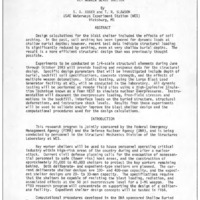-
Title
-
Design Validation Experiments For The Key Worker Blast Shelter
-
Report Number
-
CONF-8305107, p. 126-131
-
Creator
-
Kiger, S. A.
-
Slawson, T. R.
-
Corporate Author
-
USAE Waterways Experiment Station (WES)
-
Laboratory
-
Lawrence Livermore National Laboratory
-
Date
-
1983
-
Date Issued
-
1983-07
-
Extent
-
6
-
Identifier
-
ADA132780
-
Format
-
1 online resource (6 pages : ill.)
-
Abstract
-
Design calculations for the blast shelter included the effects of soil arching. In the past, soil arching has been ignored for dynamic loads at shallow burial depths; however, recent test data indicate structural loading is significantly reduced by arching, even at very shallow burial depths. The result is a more efficient structural design than was previously thought possible. Experiments to be conducted on 1/4-scale structural elements during June through October 1983 will provide loading and response data for the structural design. Specific design parameters that will be investigated include depth of burial, backfill soil specifications, concrete strength, and the effects of multiple weapon detonations. Static testing, using the Large Blast Load Generator facility at WES, will be conducted in the laboratory. All dynamic testing will be performed at remote field sites using a High-Explosive Simulation Technique known as a Foam HEST to simulate nuclear overpressures. Instrumentation will document the overpressure loading, free-field stresses and motions in the backfill, interface loads on the buried structure, structural deformations, and instructure shock levels. Results from these experiments will be used to validate and/or improve the blast shelter design and the computational procedures used for the design calculations.
-
Description
-
Design calculations for the blast shelter included the effects of soil arching. In the past, soil arching has been ignored for dynamic loads at shallow burial depths; however, recent test data indicate structural loading is significantly reduced by arching, even at very shallow burial depths. The result is a more efficient structural design than was previously thought possible. Experiments to be conducted on 1/4-scale structural elements during June through October 1983 will provide loading and response data for the structural design. Specific design parameters that will be investigated include depth of burial, backfill soil specifications, concrete strength, and the effects of multiple weapon detonations. Static testing, using the Large Blast Load Generator facility at WES, will be conducted in the laboratory. All dynamic testing will be performed at remote field sites using a High-Explosive Simulation Technique known as a Foam HEST to simulate nuclear overpressures. Instrumentation will document the overpressure loading, free-field stresses and motions in the backfill, interface loads on the buried structure, structural deformations, and instructure shock levels. Results from these experiments will be used to validate and/or improve the blast shelter design and the computational procedures used for the design calculations.
-
Distribution Classification
-
1
-
Distribution Conflict
-
No
-
DTIC Record Exists
-
No
-
Illinois Tech Related
-
No
-
Photo Quality
-
Not Needed
-
Report Availability
-
Full text available
-
Type
-
article
 article19
article19